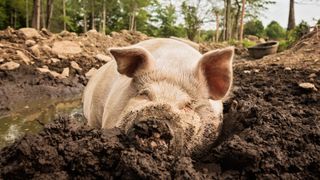
Do pigs sweat?
Why body temperature is crucial for pigs' welfare.

The phrase "sweating like a pig" may evoke mental images of streams of sweat pouring down porcine skin on a sweltering-hot day, but it is one of the English language's highly misleading idioms. Pigs have only a limited number of functioning sweat glands so they only sweat a small amount, and what little sweat they do produce doesn’t much affect their body temperature. So how do pigs cool themselves down?
Pigs are endothermic, or warm-blooded, which means they maintain a stable body temperature regardless of the temperature of their surroundings. In most cases, the body temperature of endothermic animals is warmer than that of their environment. Conversely, ectotherms, or cold-blooded animals, depend mainly on external heat sources, so their body temperature changes along with the temperature of their environment.
There are two ways that animals regulate their body temperature: metabolism and behavior. The major difference between the two types of thermoregulation is that one is rapid and the other takes a long time.
"The metabolic approach to thermoregulation is really quite slow," said Dan Tucker, a professor of veterinary public health at the University of Cambridge in the U.K. In this case, a thyroid gland-produced hormone, known as thyroxine, helps control the pig's basic metabolism, or the process in which the body turns ingested calories into energy. In turn, metabolic cycles generate heat. A 2006 paper published in the journal Physiological Reviews has shown that when pigs are exposed to consistently hot or cold temperatures over days or weeks, these cycles can be switched on or off by thyroxine to generate additional heat or cool down the body.
Related: Which animals sing?
Behavioral thermoregulation, in contrast, can help cool or raise body temperature in a much shorter time. In hot weather, pigs wallow in water or mud, which affects body temperature in a similar way to human sweat, Tucker told Live Science. As the water or mud evaporates off the pig's body, it cools the animal down. Pigs may also seek shaded areas or "conduct the heat away from their body by lying flat out on a cool surface," Tucker said. Pigs also pant to cool down. Panting increases air flow and the evaporation of water from the lungs, which releases additional heat from their body.
However, many groups within the wider pig family live in "more temperate parts of the world where they spend more energy on keeping warm than keeping cool," Tucker said. In cold weather, pigs huddle together for warmth, build nests or shiver — a behavior commonly seen in piglets just hours after they are born.
Sign up for the Live Science daily newsletter now
Get the world’s most fascinating discoveries delivered straight to your inbox.
When exposed to higher temperatures, pigs reduce how much food they consume. This is another method for cooling down, as digesting less food reduces the amount of heat produced during foraging, eating and digestion, Tucker said. A pig's body size is actually an important factor for its thermoregulation: Small pigs lose more heat through their skin than do large pigs, which have "a smaller ratio of surface area to body volume, and therefore a smaller surface area for heat to be lost," Tucker noted. Farmers, who selectively breed pigs for rapid growth and more efficient meat production, will therefore find a greater prevalence of heat stress in their herds because the pigs are bigger.
Given that exposure to hot environments can cause pigs to eat less, which in turn can lead to smaller pigs, should pig farmers be worried about the effects of climate change as average global temperatures rise? After all, heat stress can result in decreased sperm quality in boars, smaller litter sizes and inability to conceive in sows, according to a study published in the journal Acta Veterinaria Scandinavica. Longer exposure to hot temperatures can weaken pigs' immune systems, and at higher extremes, pigs can suffer hyperthermic shock — which is really cardiovascular collapse. Their blood pressure drops, which can lead to unconsciousness and even death.
"Pig meat is the second most-eaten meat globally after chicken meat," Tucker said. Farmers must consider the increasing likelihood of heat stress, not just for the value of their herds, but as an animal welfare issue, Tucker added.
So where does the phrase "sweating like a pig" come from? The phrase originates from the process of smelting iron. When hot iron is poured on sand, the cooling pieces resemble a sow and piglets, as reported by the McGill Office for Science and Society. As the surrounding air reaches its dew point, beads of moisture form on the surface of the metal, and this sweating indicates that the "pig iron" is cool enough to touch.
Originally published on Live Science on Sept. 9, 2012 and rewritten on June 13, 2022.

Martin McGuigan is an Irish writer based in Norwich, England. His work has appeared in The Mays XIX, Cabinet of the Heed and SHE magazine. His writing explores the bizarre questions of everyday life, the mysteries of human psychology, and environmental issues. He studied English literature at the University of Cambridge and creative writing at the University of East Anglia.
Most Popular



